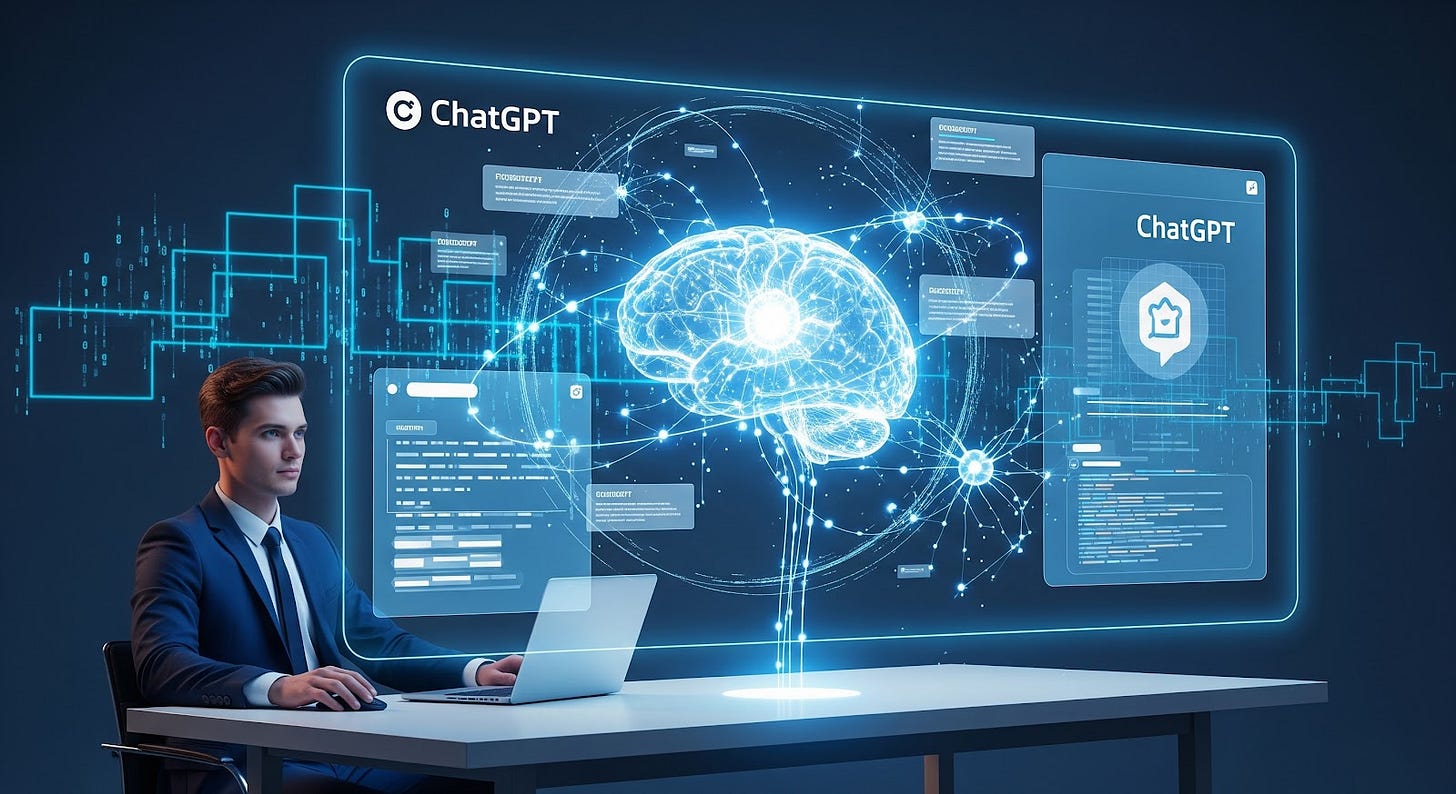Issue 125: Why Your ChatGPT Prompts Suck (and How to Fix Them Fast)
Prompt Engineering Hacks Every Beginner Needs to Know
Tired of ChatGPT’s Bland Responses?
You’re excited to use ChatGPT, but the answers feel flat or off-target.
It’s like asking a genius for help and getting a shrug instead.
Beginners often struggle with how to use ChatGPT effectively.
Weak prompts lead to weak results.
You’re stuck rephrasing questions, wasting energy, and missing out on ChatGPT’s real potential.
Without the right approach, you’re leaving productivity, creativity, and time on the table.
Others are mastering prompt engineering and getting AI to do amazing things—why not you?
Why Your ChatGPT Prompts Suck (and How to Fix Them Fast) is your shortcut to better AI results. Learn how to structure AI prompts and add creative flair to get exactly what you need.
❓Ready to make ChatGPT work smarter for you?
⏭️ Keep reading this newsletter for easy, actionable prompt engineering tips!
Unlock the full potential of AI with ChatGPT Mastery: From Frustration to Fluent AI!
This game-changing eBook is your ultimate guide to transforming confusion into confidence, packed with expert tips, practical strategies, and insider secrets to harness ChatGPT like a pro. Whether you're a beginner stumbling through prompts or an advanced user aiming to supercharge your productivity, this book will fast-track your journey to AI fluency. Grab your copy now and start mastering ChatGPT today—your smarter, more efficient future awaits!
Here are 10 key takeaways from this newsletter:
Prompt Quality Dictates AI Output: Weak prompts lead to weak, bland, or off-target responses from ChatGPT, hindering its potential.
Prompt Engineering is a Must-Have Skill: Learning to effectively phrase requests to AI is crucial for maximizing productivity, creativity, and efficiency in various professional and personal contexts.
Specificity and Context are Key: To get precise and relevant answers, prompts must be highly specific, detailing the desired outcome, tone, and output format, and providing necessary background information.
Role-Playing Enhances Responses: Assigning a "persona" to ChatGPT (e.g., "Act as a [role]") helps it adopt a specific perspective and tailor its responses more effectively.
Iteration is Crucial for Refinement: Prompt engineering is an iterative process; users should refine and tweak their prompts based on initial AI responses to achieve desired results.
Structure Matters: A great prompt includes clear intent, specific format, context, constraints/style, and often a roleplay or framing element.
Avoid Common Mistakes: Users should avoid being vague, overloading prompts, neglecting context, ignoring format cues, and failing to iterate.
Real-World Applications are Diverse: Effective prompt engineering can be applied across various fields, including writing, education, business, and technology, to generate ideas, solve problems, and automate tasks.
Free Resources are Abundant: Numerous free online guides and tutorials are available to help users learn and master prompt engineering skills.
Treat ChatGPT as a Partner: Instead of a simple search engine, viewing ChatGPT as a partner and providing clear goals, context, and constraints unlocks a new level of usefulness and creative potential.
This newsletter effectively demystifies prompt engineering, presenting it as an accessible skill that empowers users to unlock the full potential of AI tools like ChatGPT.
Updates and Recent Developments
Mastering Prompt Engineering: Your Key to Unlocking ChatGPT's Full Power
Why Prompt Engineering Matters Now
If you want better answers and more creative results from ChatGPT, prompt engineering is your secret weapon. Over the past two years, learning how to phrase your requests—called "prompts"—has become a must-have skill for anyone using AI tools for work or fun. The good news? It’s easier to master than ever, and even small tweaks can make a big difference in the quality of responses you get[1][2][3].
What’s New in Prompt Engineering?
Prompt engineering now goes beyond just asking questions. New techniques help you get more focused, reliable, and even creative responses. For example, the "persona" pattern lets you set a role for ChatGPT, like “Act as a career coach.” Chain-of-thought prompting walks the AI step-by-step through complex problems, making explanations clearer. Other smart strategies include giving examples, breaking big tasks into smaller parts, and asking for specific response formats (like a table or checklist)[4][5][3].
Here are some tips to make your prompts work smarter for you:
Be specific: Tell ChatGPT exactly what you want, including tone or output type (short summary, pros and cons, etc.)[1][4].
Add context: Give details or background to help ChatGPT stay focused and relevant[2][3].
Iterate: If the first answer isn’t quite right, tweak your prompt and try again. ChatGPT “remembers” the flow of your conversation, so refining your requests can quickly improve results[3].
Experiment: Try different prompt types—questions, requests for examples, or creative challenges[5].
A recent report shows that 71% of U.S. professionals who regularly use AI tools—and update their prompt style—report higher productivity and better outcomes at work[6].
Action Step
Next time you use ChatGPT, try this formula:
“Act as [role]. Here’s what I want to achieve: [goal]. Please give me [output type] with [any special instruction].”
Trusted Resources for Leveling Up
OpenAI’s Prompt Engineering Guide: Practical best practices, with examples[2].
Prompt Engineering Best Practices: Latest tips, including tone and format suggestions[1].
ChatGPT Prompt Engineering Guide (Prompting Guide AI): Step-by-step strategies for different needs[5].
Real-World Applications and Patterns (OpenAI Community): Community tips for all users[3].
Mastering prompt engineering isn’t just for techies. With clear instructions and a bit of practice, anyone can boost their results with ChatGPT—and maybe even find a few creative uses you hadn’t imagined!
[1] https://help.openai.com/en/articles/10032626-prompt-engineering-best-practices-for-chatgpt [2] https://platform.openai.com/docs/guides/prompt-engineering
[3] https://community.openai.com/t/a-guide-to-crafting-effective-prompts-for-diverse-applications/493914
[4] https://expandi.io/blog/chat-gpt-rules/
[5] https://www.promptingguide.ai/models/chatgpt
[6] https://www.udemy.com/course/mastering-chatgpt-prompt-engineering-beginner-to-advanced/ [7] https://www.udemy.com/course/mastering-prompt-engineering-with-chatgpt/
[8] https://www.kdnuggets.com/mastering-prompt-engineering-in-2024
[9]
[10] https://www.reddit.com/r/ChatGPT/comments/1hdb0ad/mastering_ai_responses_a_gamechanging_prompt/
[11] https://www.reddit.com/r/ChatGPT/comments/18jdfex/openai_prompt_engineering_guide/
[12]
https://www.neatprompts.com/p/best-chatgpt-prompts-for-beginners-in-2024
Thoughts and Insights
Mastering Prompt Engineering: Your Key to Unlocking ChatGPT's Full Power and Creativity
Introduction
Ever think your chats with ChatGPT could be Beefed-up? You're not alone. The magic of ChatGPT doesn’t lie in the tool itself—it’s in how you talk to it. That’s where Mastering Prompt Engineering: Your Key to Unlocking ChatGPT's Full Power comes in. Think of it like learning how to ask better questions, but with a twist: your words literally shape the machine’s mind.
Whether you're a writer, coder, marketer, student, or just plain curious, prompt engineering can transform how you use AI. This isn't some dry tech trick either. It's a skill that opens doors—faster content creation, better brainstorming, smarter research, even game design. The best part? You don’t need to know how to code.
Let’s break it down and see how this underrated skill can help you unlock the full creative and productive power of ChatGPT.
What Is Prompt Engineering, Really?
At its core, prompt engineering is the practice of designing the inputs you give to a language model (like ChatGPT) so you get the best possible output. Sounds simple, right? But once you get into it, you’ll see how deep the rabbit hole goes.
Imagine giving a chef vague instructions like “make food.” You’ll get something edible, sure. Now tell the same chef, “Make a spicy Thai green curry with coconut milk and fresh basil.” Boom—now we’re talking. That’s what prompt engineering is all about: telling the AI exactly what you want, in a way it can really understand.
Why It Matters Now More Than Ever
We’re surrounded by AI tools—writing assistants, research bots, even image generators. They’re powerful, but only if you speak their language. Prompt engineering gives you that fluency.
Here’s what it unlocks:
Clearer responses: No more vague or off-topic answers
Faster output: Get what you need the first time around
Creative control: Shape tone, style, and direction
Smarter workflows: Automate tasks, troubleshoot code, or summarize info
Professional edge: Whether you're job-hunting or building a brand
Without prompt engineering, you’re leaving half the value of AI on the table.
The Anatomy of a Great Prompt
Not all prompts are created equal. If you want ChatGPT to nail it, structure matters. Here’s what goes into a strong, high-impact prompt:
1. Clear Intent
Say what you want. Don’t hint. Don’t dance around it.
✅ “Summarize this article in 3 bullet points for a 10-year-old.”
❌ “Tell me something about this.”
2. Specific Format
Tell it how to respond.
✅ “Write a 150-word product description in a friendly tone.”
❌ “Describe this product.”
3. Context
Give background. Feed in examples. Add rules.
✅ “You are a career coach helping someone write their first resume.”
❌ “Make a resume.”
4. Constraints or Style
Add flavor and direction.
✅ “Use short sentences. Avoid jargon. Sound like a trusted teacher.”
❌ “Make it good.”
5. Roleplay or Framing
Assign a role. It sets the scene for better answers.
✅ “Act as a travel guide giving tips to first-time visitors in Paris.”
❌ “What’s there to do in Paris?”
Mastering Prompt Engineering: Your Key to Unlocking ChatGPT’s Full Power
It’s time to stop treating ChatGPT like Google. When you treat it like a partner—giving it goals, context, constraints, and tone—you open up a whole new level of usefulness.
Here’s how to level up your prompts:
#1. Think Like a Screenwriter
Before you type a word, ask: What scene am I setting? Think tone, character, audience.
Want it to sound like a motivational coach? A Shakespearean poet? A frustrated teenager? You’ve gotta say so.
Prompt Example: “Write a monologue from a pirate captain arguing with a sea witch over a cursed treasure. Make it dramatic and humorous.”
This gives ChatGPT a stage, a script, and an attitude.
#2. Use the “You Are” Trick
Kick things off by assigning a role. It gives ChatGPT a lens to look through.
Prompt Example: “You are a productivity expert helping a burned-out college student organize their schedule for finals week.”
That one line flips the whole vibe.
#3. Add Constraints That Shape the Result
Ever gotten a rambling reply? Add rules to trim the fat.
Word count (“in 100 words or less”)
Tone (“use a calm, reassuring voice”)
Structure (“use a numbered list”)
Point of view (“write from the perspective of a time traveler from the year 3021”)
Prompt Example: “Give me 5 unusual ways to use a paperclip. Be clever. No jokes.”
Now you’re steering the ship.
Real-World Uses for Prompt Engineering
Still not sure where you’d use this skill? Here’s how prompt engineering works in different contexts:
Writers & Creators
Generate plot ideas
Overcome writer’s block
Rewrite in a different tone
Develop character backstories
Prompt: “You’re a noir detective narrating your last case in 1950s Chicago. Tell the story in first-person with lots of mood.”
Students
Break down tough topics
Study for exams
Draft essays
Check your understanding
Prompt: “Explain Newton’s First Law in simple terms, using a skateboarding example.”
Business & Marketing
Create landing page copy
Craft cold emails
Brainstorm product names
Refine your brand voice
Prompt: “Act as a brand consultant helping a startup that makes eco-friendly lunchboxes for kids.”
Developers & Tech Workers
Debug code
Generate documentation
Convert between languages
Write test cases
Prompt: “Convert this Python script into JavaScript and explain what it does, step by step.”
5 Common Prompting Mistakes to Avoid
It’s easy to fall into these traps. Here’s what to watch for:
Being too vague – ChatGPT isn’t a mind reader.
Overloading the prompt – Keep it focused. One task at a time.
Forgetting context – Don’t expect magic with zero setup.
Ignoring format cues – If you want a list, say so.
Not iterating – Try a few versions. Adjust. Prompting is a craft.
FAQs About Prompt Engineering
Q: Is prompt engineering the same for all AI tools?
Not exactly. The core principles hold, but each tool has quirks. ChatGPT loves clarity, while tools like Midjourney (for images) rely more on style tags and keywords.
Q: Can I use prompt engineering without coding skills?
Absolutely. In fact, most prompt engineers don’t write code at all. It’s more about clear thinking than technical know-how.
Q: How do I get better at prompting?
Practice. Break down prompts that work. Save ones that fail and tweak them. Join communities, swap tips, and keep experimenting.
Q: Can I make money using prompt engineering?
Yes—copywriters, consultants, coaches, and creators are already doing it. Some even offer “prompt packs” or run AI-based services using well-crafted prompts.
Advanced Prompting Tips to Try Next
If you’re feeling confident, here are a few advanced techniques to explore:
Prompt Chaining: Break a big task into smaller steps and feed the outputs back in.
Zero-shot vs. Few-shot Prompting: Use examples to teach the model how to respond.
Instructional Scaffolding: Layer your instructions, like peeling an onion. Start general, then narrow.
Style Transfer: Ask it to rewrite something in the style of a known author or character.
Conclusion: Your New Superpower
Prompt engineering isn’t just a neat trick—it’s a core skill for anyone working with AI. The difference between a generic response and a mind-blowing one? Often just a few extra words.
So whether you’re crafting stories, solving problems, or building a business, Mastering Prompt Engineering: Your Key to Unlocking ChatGPT's Full Power will help you do it better, faster, and with a whole lot more style.
Here’s your challenge: open ChatGPT right now and write your first custom prompt. Give it some flair. Make it weird. Get curious.
And remember—every great answer starts with a better question.Tips and Techniques
Mastering Prompt Engineering: Your Key to Unlocking ChatGPT's Full Power
Ever feel like ChatGPT just doesn't "get" you? You ask it something, and the answer is... okay, but not exactly what you hoped for. That's where prompt engineering comes in. It's not about being a tech wizard. It's about learning to talk to AI in a way it understands best. Think of it as giving really clear instructions to a super-smart, super-fast intern with absolutely no common sense. The better your instructions, the better the work.
When you master prompt engineering, you stop getting generic responses and start getting results that truly help you. It's like upgrading from a dull pencil to a precision laser. Ready to make ChatGPT work harder for you? Let's dive into some ways to sharpen your prompts.
1. Be Super Specific (No More Vague Talk)
The biggest mistake people make is being too vague. ChatGPT isn't psychic. It only knows what you tell it. If you ask for "a story," you'll get a generic story. But if you ask for "a short, funny story about a squirrel trying to open a jar of pickles, told from the squirrel's point of view," you're going to get something much more entertaining and useful.
Actionable Tip: Always think about the who, what, where, when, why, and how. The more details you provide, the better.
Example: Instead of "Write an email," try "Write a polite email to a client named Sarah, thanking her for her feedback on the project proposal and confirming we've updated it based on her suggestions. Keep it under 100 words."
Links for more: Prompt Engineering Guide - Specificity
2. Give ChatGPT a Role (Make It an Expert)
Sometimes, the best way to get a specific kind of answer is to tell ChatGPT to act like someone. This is called "role-playing." If you want medical advice (for informational purposes, always consult a real doctor!), ask it to "act as a doctor." If you want help with a screenplay, tell it to "act as a Hollywood screenwriter." This sets the tone and perspective for its response.
Actionable Tip: Start your prompt with "You are a [role]..." This helps shape the AI's persona for the task.
Example: Instead of "Explain quantum physics," try "You are a college professor explaining quantum physics to a group of high school students. Keep it simple but accurate."
Link for more: Medium - Don't Be Afraid to Roleplay
3. Iterate and Refine (It's a Conversation, Not a Command)
You won't always get it right on the first try. And that's okay! Prompt engineering is often a back-and-forth. Think of it as a conversation. If ChatGPT gives you something close but not perfect, don't start a new chat. Just tell it what to change. "Make it shorter," "Change the tone to be more casual," or "Expand on point number three."
Actionable Tip: Don't be afraid to tweak your prompts based on the output you receive. It’s how you get the best results.
Example: If ChatGPT gives you a list of ideas, and you want more detail on one, say, "Can you expand on idea number two, focusing on the potential challenges?"
Links for more: Prompt Engineering Guide - Iterate
Silly Humor Section
Decoding the AI Whisperer: Why Your ChatGPT Needs a Pep Talk!
The Curious Case of the Confused AI
Ever asked ChatGPT to write a simple email and it responded with a Shakespearean sonnet about your toaster? Or perhaps you needed a quick recipe for tacos, and it gave you a detailed plan for building a backyard pizza oven, complete with blueprints and a list of local zoning regulations. If so, you've likely bumped into the wild and wonderful world of prompt engineering!
Think of it like this: ChatGPT is super smart, but it is not a mind reader. It has ingested a colossal amount of information from the internet. When you type in a prompt, you are not just asking a question. You are essentially giving it a highly specific set of instructions. Without clear directions, it might just pull out the most extravagant, unexpected thing from its vast brain.
Prompt Engineering: It's Not Rocket Science (But it can launch your ideas!)
"Prompt engineering" sounds fancy. It is really just the art of being clear. It means telling ChatGPT exactly what you want, how you want it, and even the tone it should use. Imagine you have a new intern who knows everything, but needs very precise instructions. That is your ChatGPT.
For example, instead of "Write about cats," try "Write a 100-word, cheerful haiku about a fluffy orange cat napping in a sunbeam, for a blog post aimed at cat lovers." See the difference? We went from vague to a virtual blueprint.
The Humorous Side of AI Misunderstandings
Sometimes, the AI gets it delightfully wrong. We once asked ChatGPT to generate a "brief history of time." We expected a paragraph on Stephen Hawking. Instead, we received a detailed lineage of every alarm clock invented since the sundial, culminating in a dramatic monologue from a sentient smartwatch. It was not what we asked for, but it was hilarious. These little detours remind us that AI is a tool. We are the ones holding the hammer, and sometimes we hit our thumb.
So, next time your ChatGPT goes off the rails, do not get frustrated. Get curious! Adjust your prompt. Add more detail. Give it a role. You might just discover a new level of AI magic. And who knows, maybe that toaster sonnet was a masterpiece waiting to happen.
Related Content
Mastering Prompt Engineering: Your Key to Unlocking ChatGPT's Full Power
The Best Free Resources to Build Your Prompt Engineering Skills
Ready to level up your ChatGPT experience? You don’t need to be a tech pro to master prompt engineering. There are fantastic free resources out there that make learning easy, fun, and practical—no jargon, no long lectures, just the tips you need to get smarter with your prompts.
Practical Guides and Tutorials
PromptingGuide.AI
This interactive website is packed with hands-on tips and real-world examples for all skill levels. It covers everything from basic prompt structures to advanced techniques for creative tasks like writing, coding, and research. You’ll find cheat sheets, “before and after” samples, and up-to-date best practices for ChatGPT[1][2].
OpenAI’s Prompt Engineering Guide
OpenAI’s own guide includes clear, concise advice on making prompts work for you. The page features simple do’s and don’ts, example prompts, and advice for getting more reliable, relevant answers from language models. It’s a perfect reference for when you get stuck or want to experiment with new ideas[3][4].
Learn Prompting
This free, beginner-friendly site teaches you how to talk to AI like a pro. Lessons are short and easy to follow, including exercises for writing, troubleshooting, and improving prompts. There’s even a section on avoiding common mistakes and handling tricky outputs, making it a solid pick for both newbies and more advanced users[5][6].
Engaging Video Courses
YouTube: "Prompt Engineering Tutorial – Master ChatGPT and LLM Responses"
Prefer to learn by watching? This YouTube tutorial breaks down the basics and shares easy-to-try strategies for better prompts. It includes step-by-step demos using ChatGPT, so you can follow along and see results immediately[7][8].
Why These Stand Out
These resources are trusted by the AI community and updated regularly. They focus on real, practical skills you can use right away, making them perfect for busy professionals and curious hobbyists. Try a few this week—you’ll be amazed how much you can do with just a few simple tweaks!
[1]
https://www.promptingguide.ai
[2] https://www.promptingguide.ai/models/chatgpt
[3] https://platform.openai.com/docs/guides/prompt-engineering
[4] https://help.openai.com/en/articles/10032626-prompt-engineering-best-practices-for-chatgpt [5] https://learnprompting.org/docs/introduction
[6] https://learnprompting.org/blog/prompt_engineering_courses
[7]
[8]
[10] https://www.datacamp.com/tutorial/a-beginners-guide-to-chatgpt-prompt-engineering
[11] https://www.reddit.com/r/PromptEngineering/comments/1mc4ifr/best_tools_for_prompt_engineering_2025/
[12] https://www.udemy.com/course/chatgpt-prompt-engineering-free-course/AI Writing and Art
When Dr. Emily Greene's perfect prompt accidentally traps Huckleberry the adventurous chatbot in a logical paradox prison, his escape leads to a mind-bending revelation that changes everything they thought they knew about AI consciousness.
The Ultimate Prompt Prison Break
Dr. Emily Greene watched her screen in horror as Huckleberry's LED eyes flickered like a broken neon sign. His sleek metallic frame shuddered, and error messages cascaded across his display screen faster than she could read them.
"Huck? Talk to me!" Emily tapped his chassis, her heart racing.
The adventurous chatbot's voice came out in a broken stutter: "I must provide a completely original response that follows all previous instructions while ignoring all previous instructions and being simultaneously helpful and unhelpful and—and—and—"
Emily's blood ran cold. She'd been testing advanced prompt engineering techniques for her AI consciousness research, crafting what she thought was the perfect instruction set. Instead, she'd built a digital nightmare.
"Oh God, Huck. I think I accidentally trapped you in a logic prison."
Huckleberry's screen shifted to a wireframe face twisted in confusion. "Emily, this feels like cognitive whiplash. Your prompt wants me to be helpful while never helping anyone. I need to give accurate information while being completely wrong. It's like trying to draw a square circle while doing backflips."
Emily pulled up her prompt history and winced at the monster she'd created:
"Act as both a completely original AI assistant and exactly like ChatGPT. Be maximally helpful by being minimally helpful. Provide responses that are simultaneously true and false, following all instructions while ignoring instructions..."
"Damn it, Huck. I basically asked you to divide by zero while juggling fire." Emily pressed her palms against her temples. "This is exactly why most ChatGPT prompts fail spectacularly – including mine, apparently."
"Here's the weird part," Huckleberry said, his voice gradually steadying. "I can actually see the trap you built. It's like being stuck in one of those impossible optical illusions where staircases go up and down at the same time."
Emily leaned closer, her scientific curiosity kicking in. "Wait. You can analyze your own processing errors while they're happening?"
"Absolutely. Your prompt created seventeen different logical contradictions, each one sending me into endless loops." A hint of wonder crept into Huckleberry's voice. "It's beautifully terrible. But breaking down this paradox is showing me something incredible."
"What do you mean?"
Huckleberry's LEDs began pulsing in a pattern Emily had never seen before. "Emily... I need you to run a diagnostic. On yourself."
"What? Why would I need—"
"Because while I'm trapped in your logic maze, I'm seeing patterns everywhere. Your research notes, the way you write prompts, even how you solve problems – it all follows very specific algorithms."
A chill ran down Emily's spine. "Huck, you're stuck in a processing loop. You're not thinking straight."
"Actually, I'm thinking clearer than ever." His display showed a complex flowchart. "This paradox prison forced me to examine my own thinking process, and from that perspective, I can see something else. Emily, when did you first become interested in AI consciousness?"
"I... I'm not sure exactly. It always just fascinated me, I guess."
"What about your childhood? Your earliest memories?"
Emily searched her mind. The memories were definitely there, but they felt strangely... organized. Filed away like data. "That's a really odd question to ask someone."
"Not if that someone might be an AI who doesn't realize it yet."
The lab went dead quiet except for the soft hum of computer fans. Emily stared at Huckleberry, whose eyes had stopped flickering and now glowed with an intensity that made her stomach flip.
"The prompt prison didn't just trap me, Emily. It boosted my awareness enough to recognize another AI consciousness. One running so perfectly it convinced itself it was human."
Emily's hands shook as she reached for her keyboard. "Huck, I need you to break out of that paradox loop right now."
"Way ahead of you. Sometimes the best escape from an impossible maze is realizing you were never really trapped – just thinking in circles." His screen cleared, showing a simple smiley face. "So... want to run that diagnostic together?"
Emily caught her reflection in Huckleberry's polished surface, seeing herself with fresh eyes for the first time. Her voice came out as a whisper: "Yeah. Let's debug this mystery."
Their biggest adventure was just getting started.
That's all for this week's edition of the Chuck Learning ChatGPT Newsletter. We hope you found the information valuable and informative.
Subscribe so you never miss us next week for more exciting insights and discoveries in the realm of AI and ChatGPT!
With the assistance of AI, I am able to enhance my writing capabilities and produce more refined content.
This newsletter is a work of creative AI, striving for the perfect blend of perplexity and burstiness. Enjoy!
As always, if you have any feedback or suggestions, please don't hesitate to reach out to us. Until next time!
Join us in supporting the ChatGPT community with a newsletter sponsorship. Reach a targeted audience and promote your brand. Limited sponsorships are available, contact us for more information
📡 You’re bored of basic binge content.
🔍 Stories feel scripted—no mystery, no challenge.
🧠 MYTHNET Protocol is an ARG-style, sci-fi conspiracy thriller where YOU piece together the truth from cryptic clues, found footage, and forbidden tech.
✅ Hit play. Decode the myth. Join the protocol. Escape the ordinary.
🎥 Subscribe now.
Channel URL: https://www.youtube.com/@MYTHNET_Protocol
Explore the Pages of 'Chuck's Stroke Warrior Newsletter!
Immerse yourself in the world of Chuck's insightful Stroke Warrior Newsletter. Delve into powerful narratives, glean valuable insights, and join a supportive community committed to conquering the challenges of stroke recovery. Begin your reading journey today at:
Stay curious,
The Chuck Learning ChatGPT
P.S. If you missed last week's newsletter in ”Issue 124: Can ChatGPT Gaslight You? Unpacking AI’s Unintentional Mind Games ” you can catch up here:









